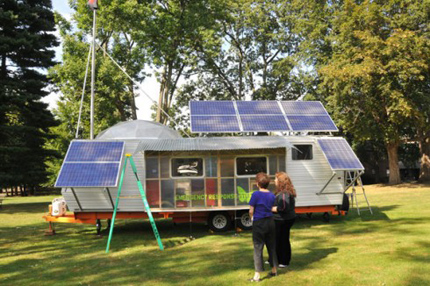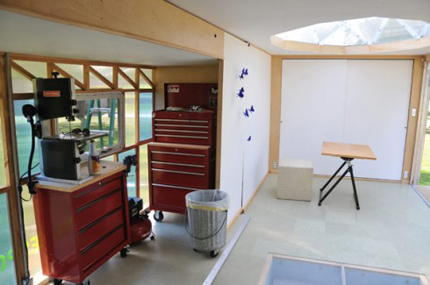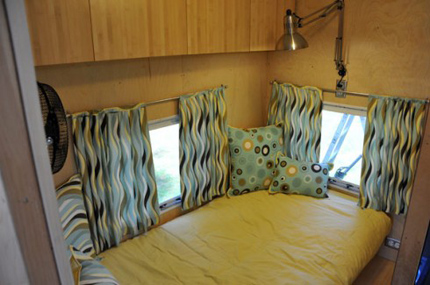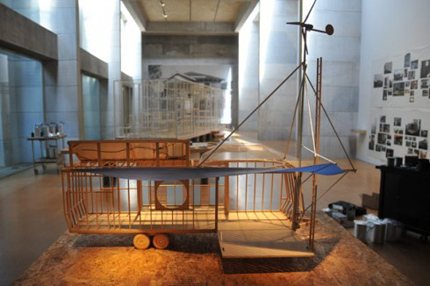
Emergency Response Studio installed at Wesleyan University's Center for the Arts. Photos: Olivia Bartlett Drake
Victims of Hurricane Katrina who were forced to live in FEMA trailers, in some cases for years, say they were exposed to toxic fumes emitted from the trailers’ formaldehyde-laden materials. That claim was recently rejected by a jury in the first lawsuit brought by a number of victims against the trailer manufacturer, Gulf Stream Coach, Inc., and Fluor Enterprises, the installer. The jury concluded that the trailers were not “unreasonably dangerous” in their construction, a notion disputed not only by the plaintiffs but also by Paul Villinski, a New York–based artist whose project, Emergency Response Studio, was inspired in part by the trailer controversy. “Why is temporary emergency housing like this?” Villinski asks, recalling the shoddy construction and off-gassing he found while creating the ERS, which involved redesigning and reconfiguring a trailer into an environmentally friendly shelter. “Why can’t we do it with a little more care and build something that is aesthetically pleasing for the occupants and also safe?

The original FEMA-type trailer was stripped of anything remotely toxic and endowed with solar panels and a geodesic skylight
Villinski’s ERS was inspired by a visit to New Orleans a year after Katrina. There he found “a disaster area” of gutted homes, streets strewn with rotting processions, still traumatized residents and a lack of manpower and resources for reconstruction. Asked to create an art project for an international art exhibition to be held in the city, Villinski, whose work focuses on repurposing found or discarded materials into beautiful objects, decided to use the notorious FEMA trailers as a way to “understand what I was seeing and what was occurring, what people were feeling and responding to, and to add something positive,” he explains. Artists, he believes, could use such trailers — made into rolling, off-the-grid workspaces — to embed themselves in emergency situations and contribute, with their creativity, to relief efforts.

Studio's sleeping area
Unable to obtain an authentic FEMA trailer from the federal agency, Villinski bought a similar model through an online auction for $5,000 and set about transforming the ripped-out interior with bamboo cabinetry, recycled denim insulation, zero-VOC paint, floor tiles made from linseed oil, and reclaimed wood. He installed solar panels, a deck and a geodesic skylight. Aluminum siding was replaced with a clear polycarbonate sheathing. After towing it to New Orleans from New York, he parked the revamped green trailer in the Lower 9th Ward, where it was a hit with local residents. (ERS was later seen in exhibitions in several cities and is on view through November 8 at the Zilkha Gallery at Wesleyan University in Middletown, Connecticut.)

Accompanying exhibition at Wesleyan's Zilkha Gallery
The ERS isn’t a production prototype, but it does function on several levels. It’s a political critique of how the recovery effort was botched by the government, and an example of what emergency housing could be with thoughtful planning and sustainable materials. It has raised consciousness, both in New Orleans and elsewhere, about the city’s revival. And it can serve as a model for how artists and designers can participate in the process of social change. “My work tends to veer in the direction of hope,” Villinski says. “It’s an exercise in what is possible.”


Comments [8]
10.05.09
05:22
10.05.09
07:19
I don't know if this work had the impact is was going for, but if it got at least one person to take some action or ask some questions I think it is a success. Of course a real solution would be the best thing but that wasn't the goal here. Design can't immediately change those lives affected, but I think it can help create a system that would better serve them and environment, which is important. It's going to take more than an artist to solve the problem of dangerous emergency housing but in the meantime art/design can get people talking and propose the kinds of solutions we really need.
10.05.09
07:51
10.06.09
01:41
10.06.09
10:36
Finally, as a resident of New Orleans, I cannot help imagining how Katrina survivors would have reacted when presented with such a construction. The memory of the trailers would have been a much more whimsical and lexically interesting history for this city, let alone wherever they happened to travel thereafter.
10.06.09
10:58
10.11.09
10:16
03.29.10
05:01